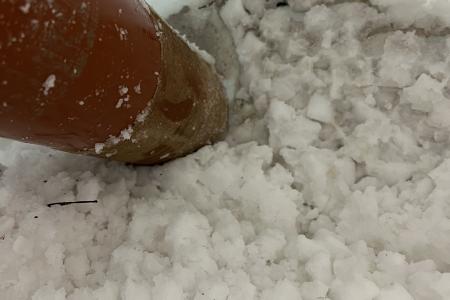__large.jpg)
See the map showing our salt delivery areas. If your delivery area does not appear on the map, please don't worry, simply contact Friendly Water on 01932 245 200 and we will be glad to offer a quote for your requirements.
Salt must be added regularly to the water softener system.
Well, as with most things in life, reduced price often means reduced quality.
But, does that matter? After all it’s just Salt. Right?
Well No!


The image above shows the inside of a water softener salt tank filled with tablet salt that has basically failed. The tablets have broken down, released contamination into the water softener. Resulting in an expensive repair.
__medium.jpg)
The second image above illustrates the difference in Quality between different sources of salt. All of the salt in this picture is brand new straight from the bag. The “Beige” salt on the left side is from a Solar Evaporated Sea Salt source manufactured in the Middle East, whereas the White salt on the right was manufactured in Northern Europe from PDV (Pure Dried Vacuum) and using BS 998 / EN973 Type A as the minimum standard.
The first and most important thing is the raw material or feed stock. Tablet salt is made from various feed stock and different sources have different purity levels.
Rock Salt – No Standards - Likely Contaminants Mud, gravel etc.
Sea Salt – No Standards - Likely Contaminants Sand, gravel organic remains etc.
Solar Salt – No Standards - Likely Contaminants Sand, gravel organic remains etc.
Food Grade – According to the International Codex Standards, For a product to be described as Food Grade it must be 97% NaCl but can originate from any of the above processes.
“Food grade salt is a crystalline product consisting predominantly of sodium chloride. It is obtained from the sea, from underground rock salt deposits or from natural brine. The content of NaCl shall not be less than 97% on a dry matter basis, exclusive of additives.”
Requires a minimum of 99.6% NaCl as well as a whole host of other standards for maximum admissible concentration of impurities as shown in this link.
https://www.british-salt.co.uk/wp-content/uploads/2022/10/BSL01-Standard-PDV-BS-998-1990-V02-1.pdf
Don’t be fooled by “Food Grade” salt the threshold for Food Grade is 97% Pure. That’s 750 grammes of impurities allowed per 25kg pack. For more about Quality standards follow this useful link.https://www.zoutman.com/en/academy/salt-for-water-treatment-all-you-need-to-know-about-quality-standards
When a salt block or tablet is standing in brine it sucks up or absorbs the Brine in which it is standing. Poorly made salt absorbs more brine. The salt block then grows “fluffy” around the edges and increases in size as the water in the absorbed brine evaporates. The “Fluffy particles then interlock with each other and link the Tablets or blocks together as one connected mass. After a while, this can cause the block grow so large that it cannot move in the front of the cabinet. Or the tablets to form a structure below which there is no salt. This phenomenon is called salt bridging. This is a condition where the softener appears to be full of salt but the salt is no longer falling or flowing into the salt tank to dissolve. This results in hundreds of service calls every year. And is not covered by any Manufacturers Warranty.